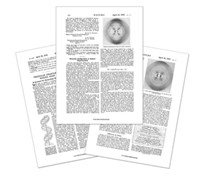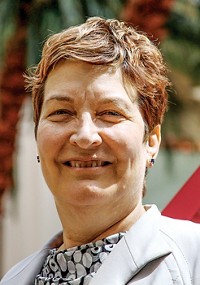Advertisement
Grab your lab coat. Let's get started
Welcome!
Welcome!
Create an account below to get 6 C&EN articles per month, receive newsletters and more - all free.
It seems this is your first time logging in online. Please enter the following information to continue.
As an ACS member you automatically get access to this site. All we need is few more details to create your reading experience.
Not you? Sign in with a different account.
Not you? Sign in with a different account.
ERROR 1
ERROR 1
ERROR 2
ERROR 2
ERROR 2
ERROR 2
ERROR 2
Password and Confirm password must match.
If you have an ACS member number, please enter it here so we can link this account to your membership. (optional)
ERROR 2
ACS values your privacy. By submitting your information, you are gaining access to C&EN and subscribing to our weekly newsletter. We use the information you provide to make your reading experience better, and we will never sell your data to third party members.
Women In Science
Indian Women In Science
Universal tales of women’s struggles to attain parity in the world of scientific research
by Vijaysree Venkatraman
January 19, 2009
| A version of this story appeared in
Volume 87, Issue 3
edited by Rohini Godbole and Ram Ramaswamy, Indian Academy of Sciences, 2008, 368 pages, $25 paperback (ISBN: 978–81–8465–005–1)

edited by Rohini Godbole and Ram Ramaswamy, Indian Academy of Sciences, 2008, 368 pages, $25 paperback (ISBN: 978–81–8465–005–1)
WOMEN ARE UNIVERSALLY underrepresented in science and technology. India, viewed as a potential powerhouse of innovations, is no exception. True, the subcontinent’s institutes of scientific learning are open to all its citizens, but potential female researchers still hesitate at the thresholds of laboratories. Is this because they have seen few role models of their gender in such establishments? “Lilavati’s Daughters: The Women Scientists of India,” edited by Rohini Godbole and Ram Ramaswamy, is an inspiring anthology published by the Indian Academy of Sciences in a bid to remedy that visibility problem.
NEW & NOTEWORTHY
INVESTIGATING SCIENCE COMMUNICATION IN THE INFORMATION AGE: Implications for Public Engagement and Popular Media, edited by Richard Holliman et al., Oxford University Press, 2008, 320 pages, $30.90 paperback (ISBN: 978–0-19–955266–5)
A collection of newly commissioned chapters by leading science communication scholars. The book addresses current theoretical, practical, and policy developments in science communication, including recent calls for greater openness and transparency, as well as for engagement and dialogue on the part of professional scientists with members of the public.
ENTERPRISE EXCELLENCE: A PRACTICAL GUIDE TO WORLD CLASS COMPETITION, by Normand L. Frigon and Harry K. Jackson, John Wiley & Sons, 2008, 496 pages, $95 hardback (ISBN: 978–0-470–27473–6)
Encourages a holistic, collaborative approach for managing and improving operations of an organization and focuses on the leadership, management, and technology of the critical systems and processes of the enterprise.
THE GREAT EQUATIONS: Breakthroughs in Science from Pythagoras to Heisenberg, by Robert P. Crease, W. W. Norton & Co., 2009, 315 pages, $25.95 hardback (ISBN: 978–0-393–06204–5)
Examines 10 of the greatest equations of all time, unearthing the rich histories, lively personalities, and brilliant minds that lurk behind every scientific formulation.
FALLING FOR SCIENCE: Objects in Mind, edited by Sherry Turkle, MIT Press, 2008, 318 pages, $24.95 hardback (ISBN: 978–0-262–20172–8)
Starting in the early 1980s, Turkle, a professor of the social studies of science and technology at MIT, began assigning her students the task of writing about an object from their childhood or adolescence that had an influence on their path into science. In the book, she collects 51 of these essays, along with eight mentor essays written by experts in the fields of science, engineering, and design.
GLOBAL CATASTROPHES AND TRENDS: The Next Fifty Years, by Vaclav Smil, MIT Press, 2008, 320 pages, $29.95 hardback (ISBN: 978–0-262–19586–7)
Identifies two basic ways in which societies experience fundamental change: sudden, often catastrophic events—volcanic eruptions, viral pandemics, wars, and large-scale terrorist attacks—and the gradual unfolding of fundamental demographic, social, economic, strategic, and environmental trends. The author assesses the probabilities over the coming five decades of the most important natural and anthropogenic catastrophes that are most likely to have global impacts, as well as the key socioeconomic trends of the next 50 years.
BLACK ROBES, WHITE COATS: The Puzzle of Judicial Policymaking and Scientific Evidence, by Rebecca C. Harris, Rutgers University Press, 2008, 208 pages, $24.95 paperback (ISBN: 978–0-8135–4369–7)
Explores the factors that influence judicial decision-making on the admission of scientific evidence in court. The author systematically examines judicial policymaking in three areas—forensic DNA, polygraphs, and psychological syndrome evidence—to answer the question: Why is scientific evidence treated differently among various jurisdictions?
CHAINS OF OPPORTUNITY: The University of Akron and the Emergence of the Polymer Age, 1909–2007, by Mark D. Bowles, University of Akron Press, 2008, 357 pages, $45.95 hardback (ISBN: 978–1-931968–53–9)
Explores the University of Akron’s pioneering contributions to rubber chemistry, polymer science, and polymer engineering. The author traces the school’s interaction with Akron rubber giants such as Goodyear and Firestone, recounts its administration of the federal government’s synthetic rubber program during World War II, and describes its role in the development and professionalization of the academic discipline in polymers that have become a pervasive part of our material lives, from toys to biotechnology.
This eye-opening collection of essays is about nearly 100 Indian women scientists from the Victorian era to present-day India. Every chapter is the story of one woman scientist living in India. Contemporary women give moving accounts of what brought them to science and what kept them going despite the exorbitant social and personal dues they paid along the way. Science historians and amateur writers present the narratives of memorable personalities who are no more. The stories are compelling even when the writing lacks finesse. As an inorganic chemist and a science writer who grew up in India and came to the U.S. for graduate studies, I find echoes from my past in every chapter of the book.
Even the title tells a tale. Lilavati was the daughter of Bhaskaracharya, the renowned 12th-century mathematician. As the head astronomer of the royal observatory in Ujjain, Bhaskaracharya authored an arithmetic text wherein he addressed problems in algebra, geometry, and discrete mathematics for his doe-eyed daughter. This classical treatise named after her is written in elegant Sanskrit verse. History does not record whether Lilavati became a mathematician herself, but the fact that her accomplished father deemed her worthy of solving those problems suggests that she indeed might have. Inheritors of Lilavati’s intellectual legacy, the women in “Lilavati’s Daughters,” with few exceptions, mention an encouraging father. Embarking on a rigorous voyage of learning would be quite impossible without such a central figure in their early years; mentors come only later.

Chronologically, the first achiever in this book is Anandibai Joshi, who, in 1886, was the first Hindu woman to obtain a medical degree in the U.S. “Before my marriage, I could barely read Marathi [an Indian language],” writes Pooja Thakar, who recounts Joshi’s story as a first-person narrative. But when 19-year-old Joshi set sail to America, she was literate in English, thanks to her husband. Readers probably recall from their university days an awkward international student who had to cope with school and culture shock simultaneously. Imagine how hard the acclimatization must have been for Joshi, an orthodox Hindu woman and strict vegetarian from the tropics facing the winters of the East Coast. For a sari-clad woman living by herself in an alien land, the weather brought forth a moral dilemma. Wearing Western attire for protection from the cold was unthinkable for Joshi, Thakar writes. At 22, when Joshi became a qualified physician, the Queen of England sent her a congratulatory note.

Among the early-20th-century women scientists, Marie Curie is one schoolchildren in India learn about, but no textbook mentions India’s own women scientists from that period. For example, in 1940, a young woman, Anna Mani, signed up to do research work in spectroscopy under Sir C. V. Raman, a Nobel Laureate in physics, at the Indian Institute of Science. Abha Sur, a science historian at Massachusetts Institute of Technology, writes in the book about this formidable woman in the chapter “An Appreciation of Anna Mani.” Although Raman was a brilliant scientist, writes Sur, he had rather quaint notions about any casual interaction between the sexes at his institute, dismissing it as “scandalous.” If the atmosphere of segregation hung heavy in the lab, Mani never let on, according to this account. She was not granted a Ph.D. despite publishing five single-author papers on spectroscopy during her time at the institute. After a long scientific career, she retired as the deputy director general of the Indian Meteorological Department.
Mani remained single all her life, but other women scientists featured in this anthology did marry. A recurring theme that runs through the book is the fact that being married entails a long list of family responsibilities for Indian women, which sometimes eats into the time they can devote to science.
In her essay, “A Career in Mathematics,” Mangala Narlikar wistfully describes herself as a part-time scientist. She finished a Ph.D. in mathematics 16 years after she got married. Household responsibilities came first for this self-effacing mother of three and wife of a famous Indian astrophysicist. Her story, she writes, is representative of many in her generation born around the year of India’s independence in 1947. In the chapter “Negotiating Choices,” Charusita Chakravarty, a present-day chemist who relinquished her U.S. citizenship and now works in India, writes that women make matrimonial decisions in their late 20s and early 30s. But during this same period, they have to establish themselves as independent researchers, just like their male colleagues, she points out.
MOTHERHOOD usually follows matrimony. In India, a developing nation with few quality child care centers, reliable help comes from considerate grandparents, but this happens only when they don’t need care themselves. In the chapter “Why and How I Became a Scientist,” biochemist Maharani Chakravorty recalls taking her infant along to her workplace. “The poor child used to sit on the rubber sheet spread on the floor of the laboratory playing with test tube stands, right there in front of my working bench,” she writes. Some contributors to the book proudly mention in their essays the fact that their children have become researchers themselves. Sulochana Gadgil, a Harvard University-trained meteorologist, writes in the chapter “My Tryst with the Monsoon” that her mathematician son made critical contributions to two of her recent papers.
Without enlightened policies in the workplace, women scientists can find it hard to realize their potential. In this book, more than one woman mentions years of separation from her spouse because it was too difficult to get appropriate work in the same Indian city. In the chapter “She Was a Star,” the woes and achievements of Darshan Ranganathan, an organic chemist who was also married to one, are recounted by her husband. He writes that she languished as a research associate when he was a professor of chemistry at the Indian Institute of Technology, Kanpur (IITK), because an unwritten rule forbids spouses from simultaneously holding faculty positions in the same department. “I am left with the wistful feeling that Darshan would have flowered more, much earlier, had she been offered a faculty position at IITK,” writes D. Balasubramanian, director of the L. V. Prasad Eye Research Institute, in a moving tribute to Ranganathan, who died of cancer in 2001 (Curr. Sci. 2001, 81, 217). The Indian National Academy of Science has instituted a biennial lecture in her memory.
Thanks to this book, aspiring women scientists in India can find role models closer to home. Readers with no connection to the subcontinent may enjoy many of the essays because few stories are more heartwarming than that of an underdog who wins against the odds. Clearly, many of these women were by no means favorites. One chapter is about a mathematician who, as a little girl, sported a turban and disguised herself as a boy to attend school. Her uncle, a village headman, thought that educating her was pointless and said so. A city school principal requested female students who had done well in the qualifying exams to give up their spot in science to boys because lab space was scarce. His reasoning was that women only have to work in the kitchen; a science education would be wasted on them.
Given this milieu, what these women have accomplished in the rarefied field of research is nothing short of amazing. The book acknowledges their lonely struggles. Although this anthology has no manifesto, nearly every essay hints at the fact that the establishment can do more to accommodate highly qualified women who want a career in pure science. Open-minded policymakers in India looking for ways to retain talent in research institutes can certainly find some answers here. And despite cultural differences, readers from elsewhere are likely to find unexpected resonances in these narratives on and by women scientists. That is, in part, a testimony to the universality of a life in science. Sadly, it also reveals the ubiquity of the bias faced by women pursuing this demanding vocation.
Vijaysree Venkatraman is a Boston-based science writer.





Join the conversation
Contact the reporter
Submit a Letter to the Editor for publication
Engage with us on Twitter